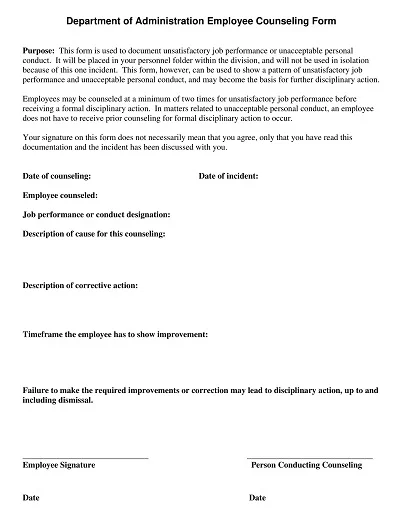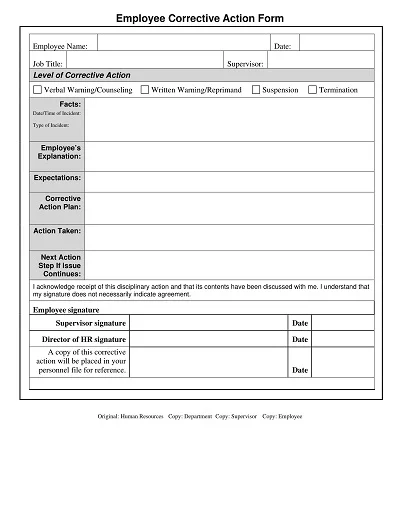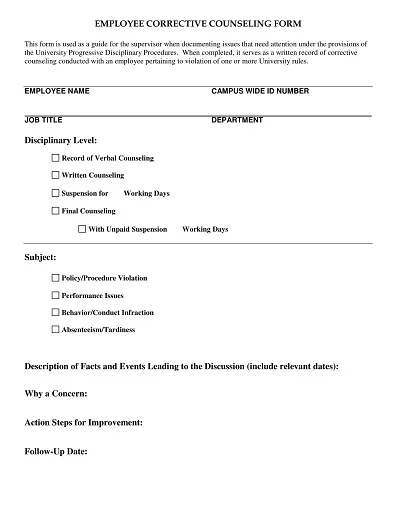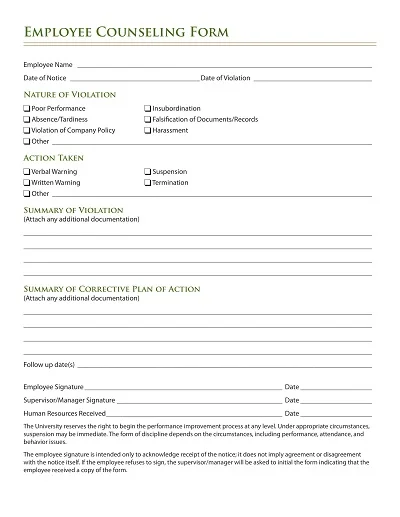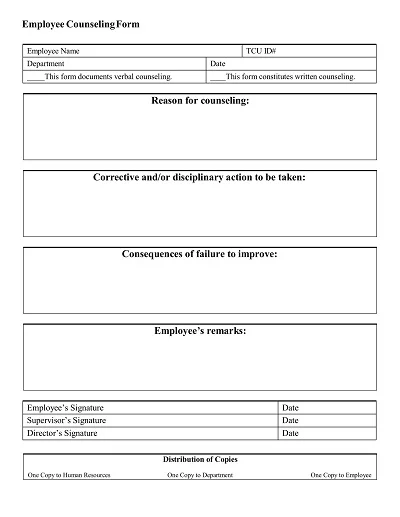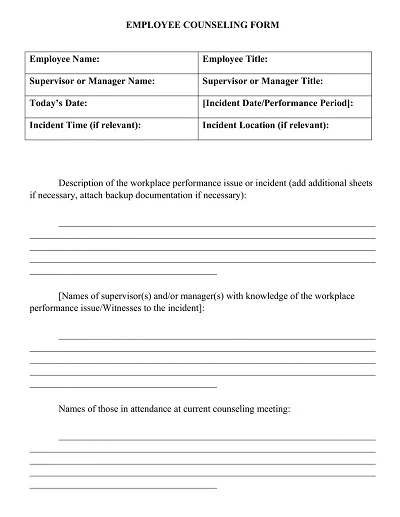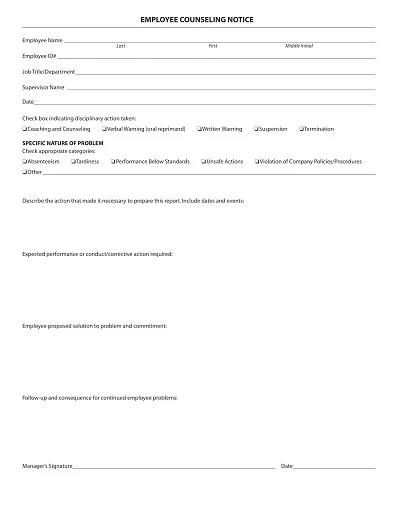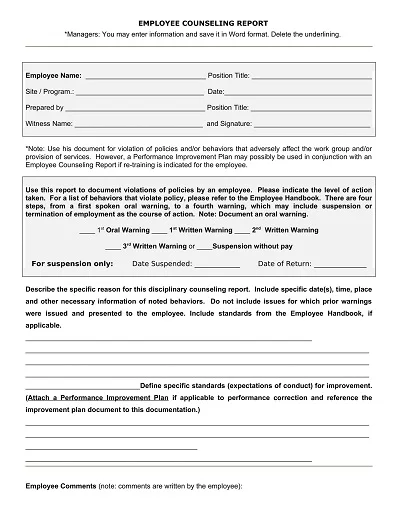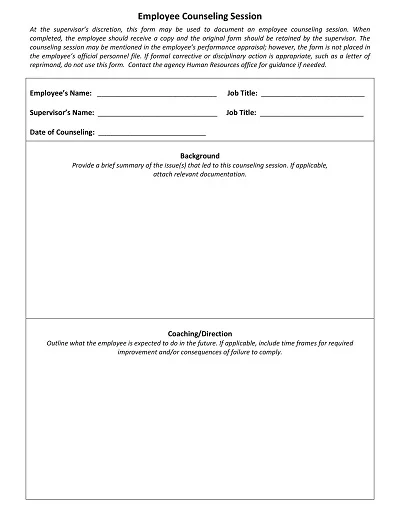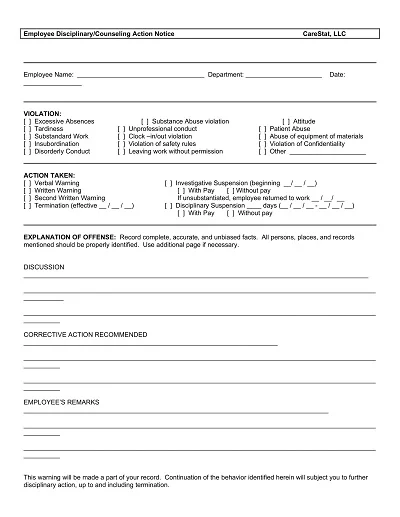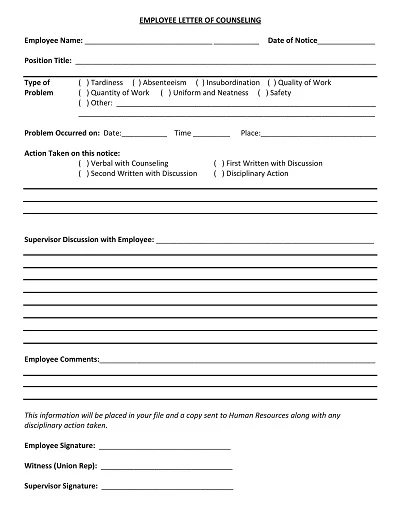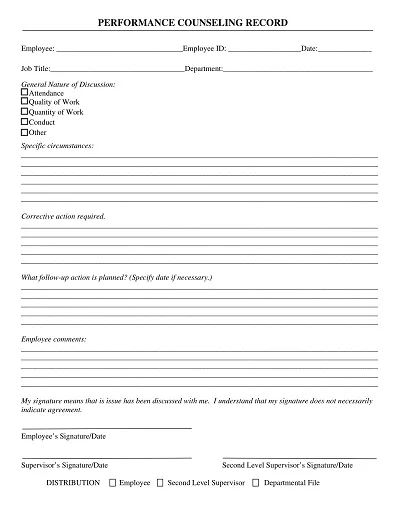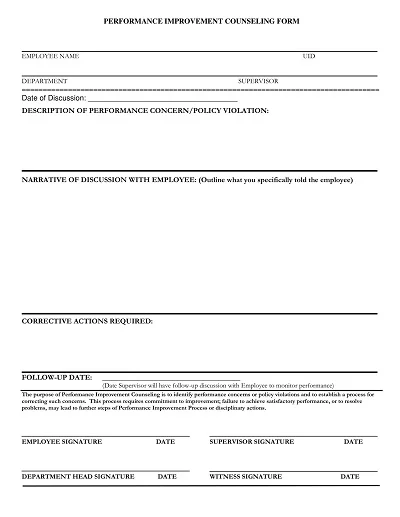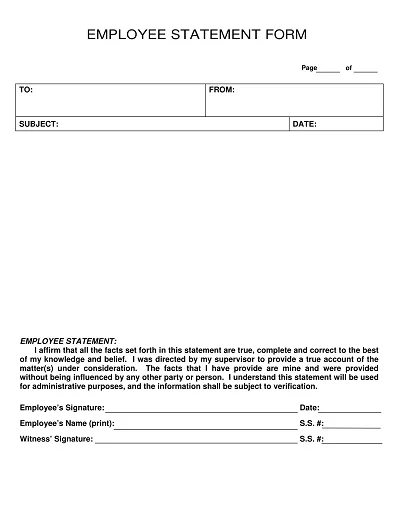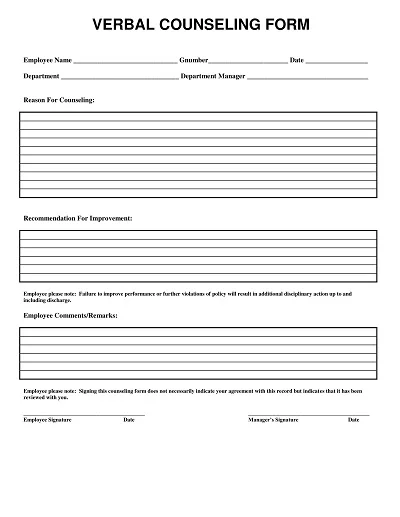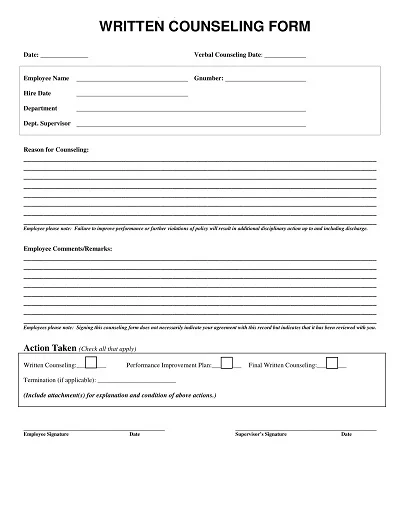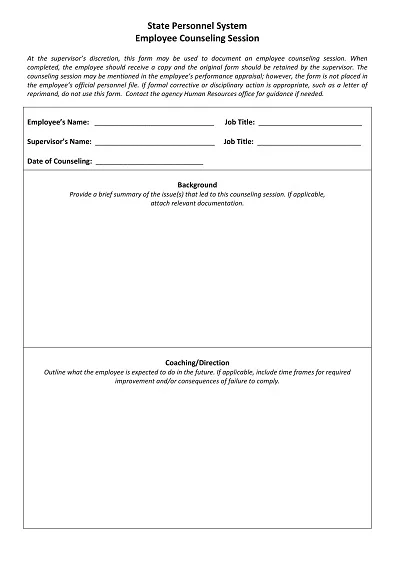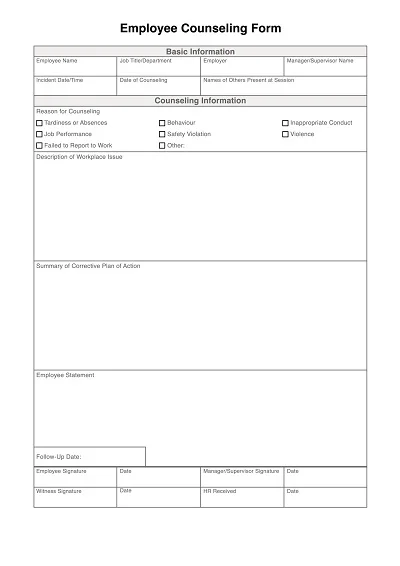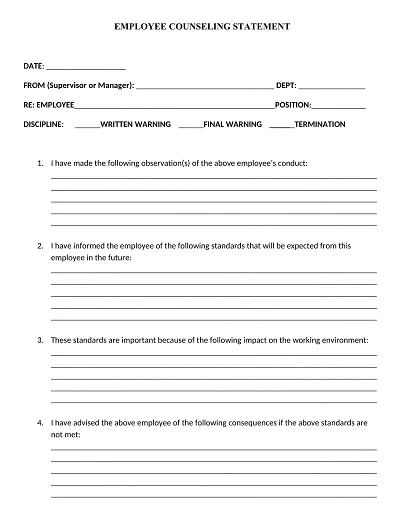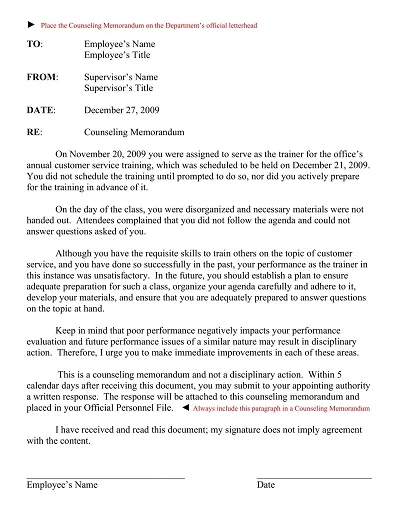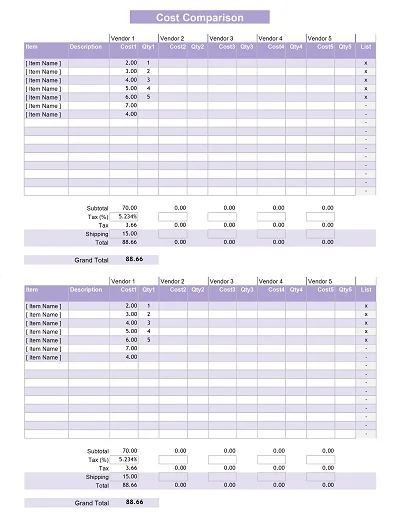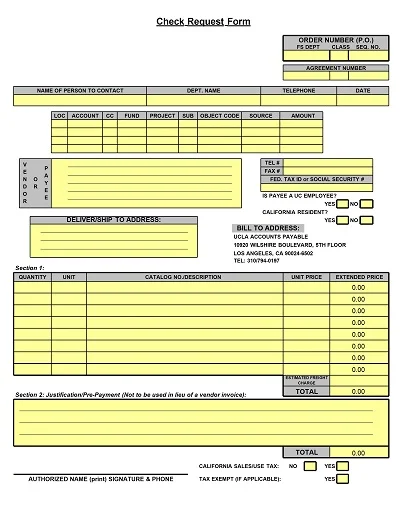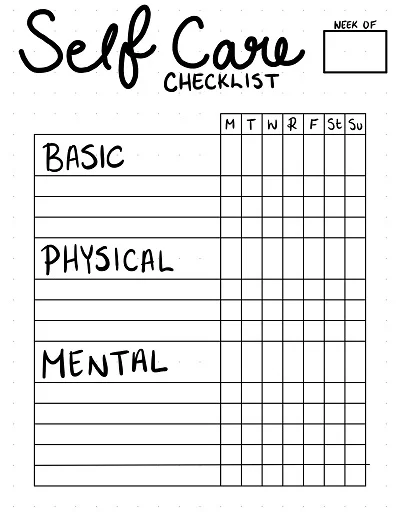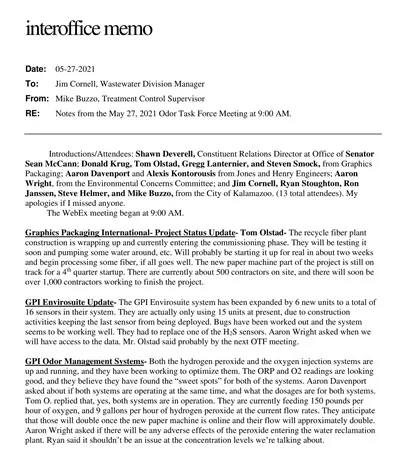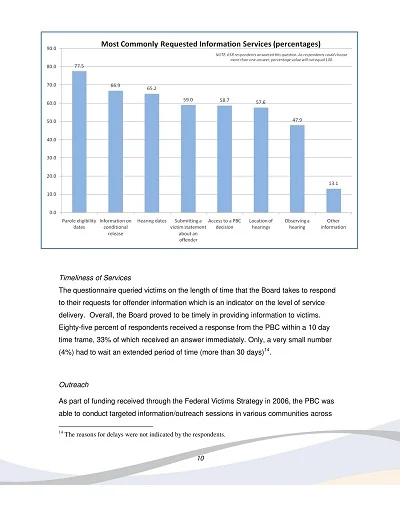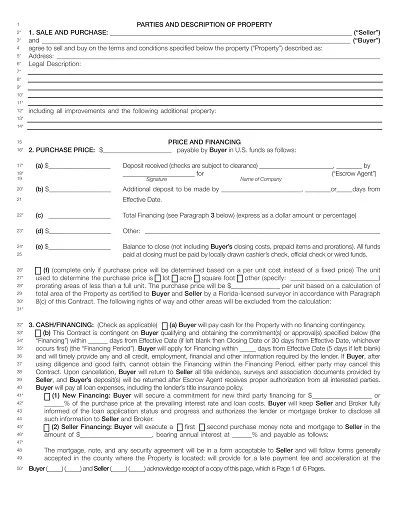Employee counseling and adequate staff relationship management are crucial in the organization’s human resource management process. An employee concern reporting form is beneficial in tracking problems and solutions that may be encountered during the course of work. This could be anything from a more practical problem involving performance, behavioral problems, constantly arriving late for work, or anything else that requires intervention from an official standpoint.
It serves as an effective reference that captures the nature of the problem and corresponds to the agreed-upon changes. In the subsequent sections, we have outlined an exhaustive example of an Employee Counseling Form template as a reference point for your organization.
Download Free Printable Employee Counseling Form Templates
What is an Employee Counseling Form?
Employee Counseling form is an important document that organizations employ to handle and record occurrences that may occur within the processing period of an employee. This form may be used for any issues ranging from performance issues, disciplinary cases, truancy, or any other subject matter requiring official handling.
It serves as a documentation of the concern and a tool to document the plans and solutions thereon. This documentation is useful for ensuring that the knowledge documented within an organization is transparent and accountable. Also, it guarantees proper counseling planning, including the manner and construction of the statement between the employee and the management, besides enhancing general performance and order within the company.
Components of an Employee Counseling Form
Employee Counseling Form usually includes several elements that make counseling sessions between the manager and the employee as effective as possible.
- Employee Information: These features should include but not be limited to the employee’s name, job title, department, or any other identification number.
- Issue Description: A brief, yet straightforward elucidation of the subject matter of the particular article or paper in question. This is as important as water for fish because it calls for background information and definitions for issues that should be discussed.
- Previous Actions: If any measures were taken to address the problem, these should be added, especially the feedback session or training.
- Counseling Session Details: The following points are summarized from the counseling session. This may include the statement made by the manager, the response made by the employee, and their contentious issue.
- Action Plan: Promised actions by the employee about how he or she shall seek to enhance or correct the situation. This may involve modifications in behavior, receiving more training, or any other course of action.
- Follow-up Dates: The meeting schedule when follow-up meetings should be held to discuss the outcomes of the implemented action plan.
- Signatures: Last but not least, the manager, along with the employee, should endorse the form wherein both parties accept the report contents and action plan. This explains the aspect of accountability across the two nations.
Benefits of Using an Employee Counseling Form
Benefits of using an Employee Counseling Form are multiple, contributing not only to the individual growth of employees but also to the organization’s overall health:
Boosts Employee Engagement
This, in turn, could enhance the Employee Counseling Forms to increase engagement. When problem-solving and concerns are addressed, the employees get a sense that they are being listened to and taken care of, which makes them work harder and focus on the company. Second, tenants are likelier to be committed and feel the duty to work hard and contribute their best effort.
Supports Legal Compliance
In addition, all these forms help organizations adhere to the legal requirements of the country they operate in. These documents come in handy when the employees have taken legal recourse to help the organization demonstrate that it did act by the law. This can be important in cases where a problem is being solved between two parties and the organization follows the proper procedures of addressing the issue.
Enhances Communication
Counseling Forms can play a vital role in improving communications in the workplace and between the employees and the management in particular. It affirms an increased structure for stepping into obvious and blunt complications. It can intimate a first-class way of arrival at distinct apprehensions of each party’s feelings and estimates. This may enhance rapport between the staff and a better synergy in their work setting.
Facilitates Managerial Decision-Making
They can also contribute to the managers’ decision-making process within an organization. This way, by following an employee’s performance and actions, management collects relevant information to help them decide on any promotion, dismissal, or anything else involving the employees. Another benefit of performing these analyses is that it can lead to decisions that are more accurate and suited better to the organization.
Leads to Fruitful Combats
These forms may help prevent and manage conflict within the organization due to their ease in educating employees about their rights and responsibilities in various disputes. These forms are engrossed in a structured form where completing the forms produces clear and structured documentation of disputes and disagreements. This, action plan and follow-ups may all help a situation and its conflicts to be worked out more thoroughly, thus improving the workplace environment.
How to Fill Out an Employee Counseling Form
Employee Counseling Form is a document that must be completed thoroughly and with great precaution as it involves communication between the employee and the management.
Here are some steps to guide you through the process:
- Employee Details: First, provide information on the specific employee being counseled, such as his full name, his /her position, department, and date of counseling.
- Identify the Issue: Explain why the person is seeking counseling or the problem they want to address. It can be a failure in productivity, a disciplinary matter, or a conflict with another team member. Make it as specific and businesslike as possible.
- Discuss the Impact: Discuss how the issue influences the work output of the individual or group, team cohesiveness, or organizational climate. This, in a way, aids in substantiating the issue of concern.
- Present Evidence: If possible, provide reasons supporting observed findings. This could include performance reports, emails, statements, or any other documentary evidence as may be applicable.
- Outline the Expectations: In this case, the employee must set expectations regarding the issue. Here one could experience a change in behavior, enhanced performances, or even conflict issues being addressed.
- Develop an Action Plan: Come up with a contingency plan that should be implemented with the assistance of the particular employee. A suggestion would be for the employee to act upon it and what the organization will do to offer help and support.
- Set a Review Period: Schedule a time when you should meet, to assess the employee’s progress in completing tasks. This may take several weeks or even months depending on the level of the issue at hand.
- Signatures: Last, the counselor, who can also be the manager or the HR representative, should append their signature on this form to confirm recognition of the conversation and the actions made.
How to Create an Employee Counseling Form Template
Each corporation has a different way of handling the counseling activity, but the development of an Employee Counseling Form Template simplifies this activity.
Here are the steps to create a basic template:
- Header: Start with an initial text banner that contains your organization’s name and logo.
- Title: Follow it up with a clear and concise title usually in capitals, such as “Employee Counseling Form”.
- Employee Information: While it is crucial to include fields for essential employee identification it is recommended to add fields for the following:
- Employee Name
- Job Title
- Department
- Date of Counseling Session
- Issue Description: It is necessary to devise an introduction part that will present the problem or problem area briefly and objectively.
- Impact Discussion: TIP: Also provide a space for the client to explain how this issue affects their work, productivity, or the work setting.
- Evidence Presentation: Copyright You might want to add a field where existing evidence to support the observations can be uploaded or the file can contain an explanation of the same.
- Expectations: As part of it, a section outlining your expectations as an employer from the employee in the issue is included.
- Action Plan: To address the issue, the heading accompanying the documentation should feature an action plan, where the particular measures the employee should follow can be outlined.
- Review Period: An option or field should be provided that will enable the employer to set a date or period for the employee to be reviewed.
- Signatures: It is also desirable to offer the places at the end of the form, which must be signed by the counselor and the employee, indicating that all the issues have been discussed and the measures have been worked out.

